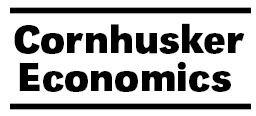Agricultural Economics, Department of

Cornhusker Economics
Date of this Version
2-26-2020
Document Type
Newsletter Issue
Citation
2020 Author
Abstract
Nebraska property taxes are the ninth highest in the United States. Nebraska ranks 41st in terms of property taxes (a smaller number means lower property taxes, while a higher number means high- er property taxes). By comparison, Missouri ranks 7th, Colorado is 14th, Kansas is 20th, South Dako- ta is 22nd, Iowa is 35th, and Wyoming is 39th. So Nebraska property taxes are high both regionally and nationally.
Nebraska sales taxes are the ninth-lowest, and both state income taxes and total state taxes are in the middle. Property taxes account for 38% of total state and local tax collections in Nebraska, the highest of any tax. Sales taxes are 29% of total tax collections, and income taxes are 26%. Homeowners pay 47% of Nebraska property taxes; farmers and ranchers pay 29% and commerce and industry pay 17%. If property taxes, sales taxes and income taxes were equalized as sources of state and local revenue, property taxes would need to be reduced over $600 million.
Sixty percent of Nebraska property taxes go to K- 12 education funding. Nebraska state school aid is the second-lowest in the U.S., while the local share of K-12 school spending is the second-highest. Nebraska property taxes on agricultural land historically have been high relative to other states as a percent of net farm income. Since 1950, Nebraska property taxes on agricultural land have been 46% higher than the United States average. In 2017 agricultural property taxes paid were 47% of Nebras- ka net farm income. When other taxes are taken into account, this means that most Nebraska farmers or ranchers were paying 50-60% of their net farm income in taxes.


Comments
agecon.unl.edu/cornhuskereconomics